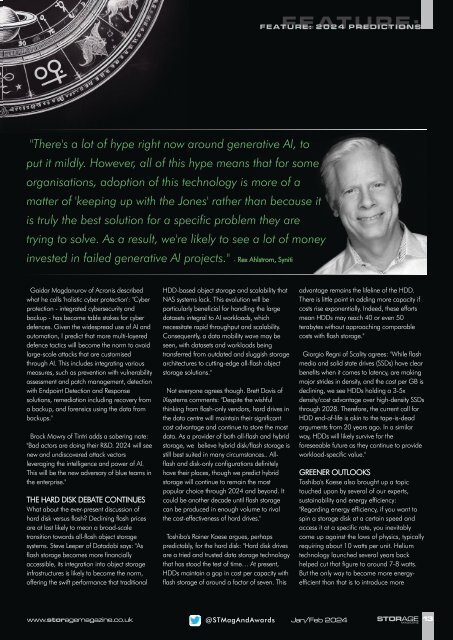ST2401
Create successful ePaper yourself
Turn your PDF publications into a flip-book with our unique Google optimized e-Paper software.
FEATURE:<br />
FEATURE: 2024 PREDICTIONS<br />
"There's a lot of hype right now around generative AI, to<br />
put it mildly. However, all of this hype means that for some<br />
organisations, adoption of this technology is more of a<br />
matter of 'keeping up with the Jones' rather than because it<br />
is truly the best solution for a specific problem they are<br />
trying to solve. As a result, we're likely to see a lot of money<br />
invested in failed generative AI projects." - Rex Ahlstrom, Syniti<br />
Gaidar Magdanurov of Acronis described<br />
what he calls 'holistic cyber protection': "Cyber<br />
protection - integrated cybersecurity and<br />
backup - has become table stakes for cyber<br />
defences. Given the widespread use of AI and<br />
automation, I predict that more multi-layered<br />
defence tactics will become the norm to avoid<br />
large-scale attacks that are customised<br />
through AI. This includes integrating various<br />
measures, such as prevention with vulnerability<br />
assessment and patch management, detection<br />
with Endpoint Detection and Response<br />
solutions, remediation including recovery from<br />
a backup, and forensics using the data from<br />
backups."<br />
Brock Mowry of Tintri adds a sobering note:<br />
"Bad actors are doing their R&D. 2024 will see<br />
new and undiscovered attack vectors<br />
leveraging the intelligence and power of AI.<br />
This will be the new adversary of blue teams in<br />
the enterprise."<br />
THE HARD DISK DEBATE CONTINUES<br />
What about the ever-present discussion of<br />
hard disk versus flash? Declining flash prices<br />
are at last likely to mean a broad-scale<br />
transition towards all-flash object storage<br />
systems. Steve Leeper of Datadobi says: "As<br />
flash storage becomes more financially<br />
accessible, its integration into object storage<br />
infrastructures is likely to become the norm,<br />
offering the swift performance that traditional<br />
HDD-based object storage and scalability that<br />
NAS systems lack. This evolution will be<br />
particularly beneficial for handling the large<br />
datasets integral to AI workloads, which<br />
necessitate rapid throughput and scalability.<br />
Consequently, a data mobility wave may be<br />
seen, with datasets and workloads being<br />
transferred from outdated and sluggish storage<br />
architectures to cutting-edge all-flash object<br />
storage solutions."<br />
Not everyone agrees though. Brett Davis of<br />
iXsystems comments: "Despite the wishful<br />
thinking from flash-only vendors, hard drives in<br />
the data centre will maintain their significant<br />
cost advantage and continue to store the most<br />
data. As a provider of both all-flash and hybrid<br />
storage, we believe hybrid disk/flash storage is<br />
still best suited in many circumstances.. Allflash<br />
and disk-only configurations definitely<br />
have their places, though we predict hybrid<br />
storage will continue to remain the most<br />
popular choice through 2024 and beyond. It<br />
could be another decade until flash storage<br />
can be produced in enough volume to rival<br />
the cost-effectiveness of hard drives."<br />
Toshiba's Rainer Kaese argues, perhaps<br />
predictably, for the hard disk: "Hard disk drives<br />
are a tried and trusted data storage technology<br />
that has stood the test of time… At present,<br />
HDDs maintain a gap in cost per capacity with<br />
flash storage of around a factor of seven. This<br />
advantage remains the lifeline of the HDD.<br />
There is little point in adding more capacity if<br />
costs rise exponentially. Indeed, these efforts<br />
mean HDDs may reach 40 or even 50<br />
terabytes without approaching comparable<br />
costs with flash storage."<br />
Giorgio Regni of Scality agrees: "While flash<br />
media and solid state drives (SSDs) have clear<br />
benefits when it comes to latency, are making<br />
major strides in density, and the cost per GB is<br />
declining, we see HDDs holding a 3-5x<br />
density/cost advantage over high-density SSDs<br />
through 2028. Therefore, the current call for<br />
HDD end-of-life is akin to the tape-is-dead<br />
arguments from 20 years ago. In a similar<br />
way, HDDs will likely survive for the<br />
foreseeable future as they continue to provide<br />
workload-specific value."<br />
GREENER OUTLOOKS<br />
Toshiba's Kaese also brought up a topic<br />
touched upon by several of our experts,<br />
sustainability and energy efficiency:<br />
"Regarding energy efficiency, if you want to<br />
spin a storage disk at a certain speed and<br />
access it at a specific rate, you inevitably<br />
come up against the laws of physics, typically<br />
requiring about 10 watts per unit. Helium<br />
technology launched several years back<br />
helped cut that figure to around 7-8 watts.<br />
But the only way to become more energyefficient<br />
than that is to introduce more<br />
www.storagemagazine.co.uk<br />
@STMagAndAwards Jan/Feb 2024<br />
STORAGE<br />
MAGAZINE<br />
13
















